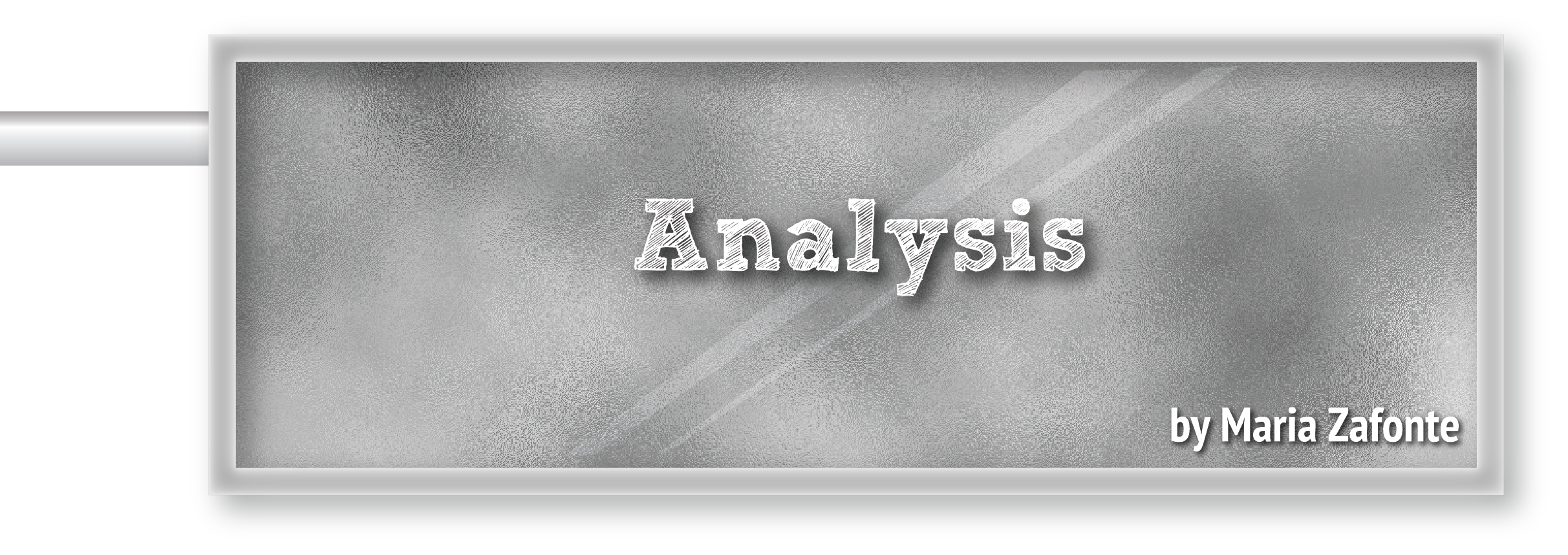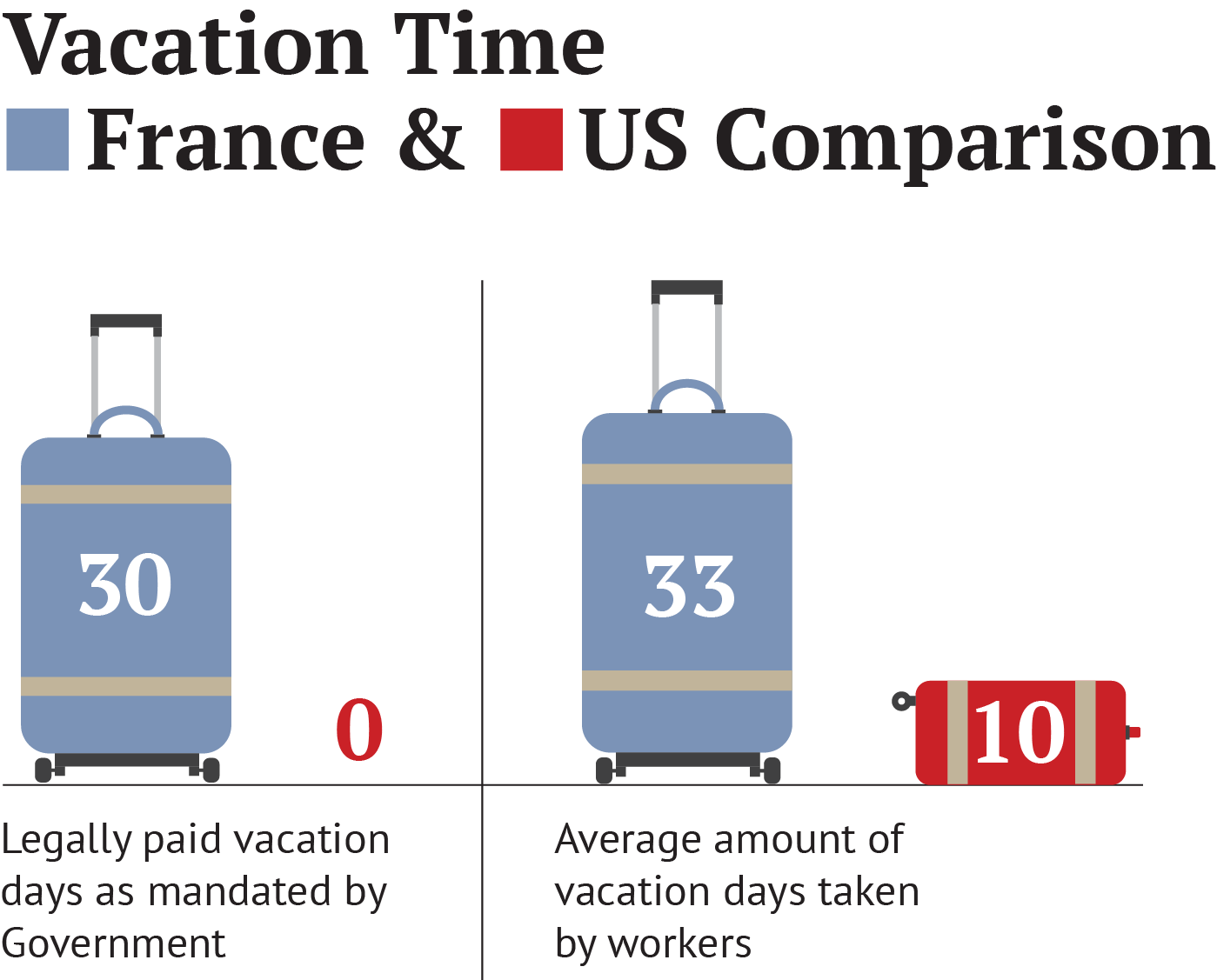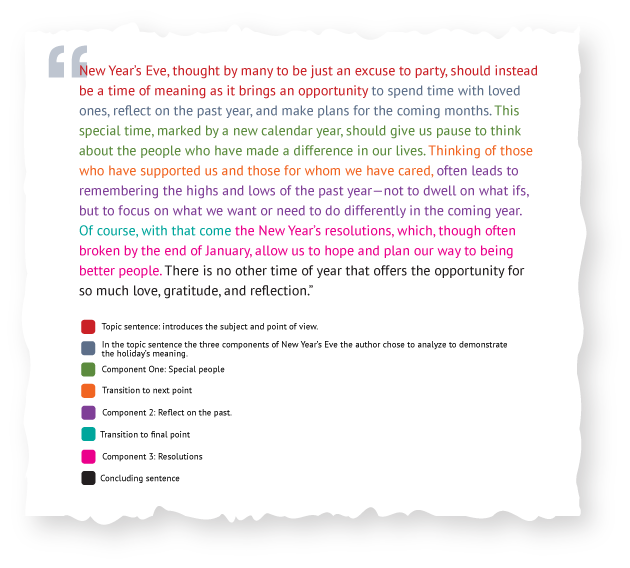
Before you begin reading this chapter, please take this quiz to see what you already know about analysis.
Introduction to Analysis
What does this graph show? Some possibilities might include that America has a Puritan work ethic, meaning that working hard is part of America's national identity; that the United States has fewer social supports, so citizens must rely on their employers and job performance for security; that the pace of life is more frenetic in the United States; or that Americans want less government involvement in their lives. In analyzing the French data you might say that they enjoy life more, follow the phrase “work to live, not live to work,” value leisure time more than money, and have some security in the medical and social supports provided by their government. When you begin to dig into the data to uncover what it means, you are doing analysis. Analysis aims to, as the derivation suggests, unloose meaning from facts. Analysis aims to answer how and/or why. Purpose of AnalysisAnalysis is necessary because humans have a need to understand the meaning of the world around them and evaluate the people, ideas, events, and objects they encounter. Analysis helps to unloose meaning, look deeply, and make sense of things. Analysis to InformAnalysis helps you to better understand meanings and gives you a way to make sense of the information with which you are presented. For example, when a friend tells you that he just saw the best movie, typically, you do not just take him at his word and run out to see it. Your friend explains, or you ask, what about the movie made it so good. Was it the storyline, the acting, the special effects, or the action? Understanding what aspects of the movie your friend thought made it good helps you to determine whether you would like it too. If your friend says the movie was fantastic because of action sequences with tons of violence and explosions, but you do not enjoy such movies, you now know to avoid that movie. Your friend's analysis has made you better informed. Analysis to PersuadeAnalysis can be used to persuade an audience about the value of a certain idea, object, or event. Perhaps you want to convince a friend that your college offers a great experience. You might try to convince him or her by breaking down the experiences you had at your school into meaningful components, such as challenging academics, knowledgeable instructors, and interesting social experiences. These are important areas to prospective college students, and examining them in detail helps to persuade the audience that what you are saying is true. Analysis backs up and proves your point. Identifying the SubjectAlmost anything can be the subject of analysis. Often, analysis works really well for reviewing movies, restaurants, books, and events. Anything that can be broken down into component parts would work. The main point of analysis is that you want to look at something more deeply and unloose its pieces so you get a better idea of the whole. It is also a good idea to keep your topic as small as possible. For example, instead of analyzing dogs, you might choose instead to analyze Dalmatians; or instead of analyzing a holiday or a celebration, you could narrow down the topic to New Year's Eve. Adding specificity to your choice makes the analysis more focused, meaningful, and interesting. Breaking Down the Parts of the SubjectOnce you have a strong, specific topic, your next task is to break it down into its component parts. In what meaningful ways can you break down the topic so that you can show how those components add up to the quality of the whole? Using the sample topic of New Year’s Eve, brainstorming might produce the following components of the holiday:
Identifying the Function of the Parts in Relation to the WholeOnce you have identified several possible components of your subject, you need to think about how they make sense together. Remember the parts you choose must work together in a comprehensive thesis statement, so they have to be related so your analysis can add meaning. Returning to the New Year's Eve topic, there are a few ways to group the listed parts. The ones that seem most intuitive and meaningful that will work nicely together might be: spending time with friends and family, reflecting on the past year, making resolutions, and thinking about what you want to do better in the coming year. United, these parts create a strong topic sentence for a paragraph or a thesis statement for an essay. By combining those three parts, a topic sentence might look like this: New Year’s Eve, thought by many to be just an excuse to party, should be a time of meaning as it brings an opportunity to spend time with loved ones, reflect on the past year, and make plans for the coming months. So, by choosing those components to analyze, the writer demonstrates that New Year’s Eve, at least to this writer, is a time of meaningful reflection. Choosing the parts is key. For example, banging pots outside at midnight, though fun and celebratory, does not fit in with the three points chosen. Choose components that, once analyzed, bring meaning back to the whole. Explaining the Significance of AnalysisWith the three components and the topic sentence, you are now able to put it all together into a first draft of a paragraph. This is where you explain each component and show how it is significant to the analysis—in other words, make meaning of the parts. 
Critical-Thinking ApplicationsLike most other types of college writing, these essay types are studied because they provide effective ways to organize ideas and communicate them to an audience. Below are a few ways that analysis can be used in everyday writing. Writing as a Global CitizenAnalysis is a perfect tool to use to bring awareness to others. If there is a cause you feel strongly about, a candidate you support, or an issue to which you feel particularly dedicated, using analysis to break down the issue and make meaning of it allows you to explain its significance to others. As a global citizen, you might choose to write a letter to the editor of your local newspaper, present information in your church bulletin, or post your thoughts on your Facebook page or other social media outlet. With analysis as the base of your argument, you can be sure to highlight the main points and show the significance of your cause or issue. College WritingAnalysis is the heart of college writing. Even though college writing may use words such as compare, persuade, examine, or argue, the foundation of each of these tasks is analysis. One of the most straightforward examples is found in a literature or textual analysis class. When you are asked to write about a novel or story, the instructor is not asking for a summary of the book; instead, they want to know what you make of it. They want you to take it apart, put it back together, and make meaning out of it. You might analyze it by the realistic characters the author creates, the excitement of the plot, or the tone of suspense that the mystery writer creates. Whatever aspect you are asked to analyze, you must look deeply at individual components of the text and add meaning to the whole. Writing for Your CareerWhile your boss is unlikely to assign you an essay, it is completely realistic to think that your opinion will be solicited at some point, and you might need to put it in an email. Perhaps your supervisor will ask for your opinion on new technology or software the company is thinking about implementing, or a colleague might want to know about the effectiveness of a certain course of treatment. In both cases, when you are asked to evaluate something for the purpose of helping others, and perhaps yourself, analysis will help you to see it clearly. Professional WritingProfessional writers and journalists constantly use analysis in trying to convey key issues and points to audiences. Though professional writers' work might not be structured as obviously as a college essay is expected to be, the analysis task is a key part of how a professional writer conveys information. Detailing what a candidate stands for or examining consequences of legislation are all ways that journalists move from straight reporting to what the story could mean to the reader. Personal WritingIf you have ever kept a journal or diary, you have probably done some personal analysis. Writing down events and encounters that have happened in your life can be a way of record keeping, or summarizing the key plot points of your life. Often, when journaling, writers go beyond just recounting facts and people and look to make meaning. When this happens, the writer is analyzing, though in a more free-form way than in an essay. ExamplesStudent Paragraph 1: CoffeeMany events in a young person’s life signal that they have come of age and achieved grownup status, but, in my mind, nothing signifies this more than drinking coffee. A coffee pot in which I can brew my own coffee means I have grown-up habits, refined tastes, and a timetable of my own. During study sessions, my friends are loading up on caffeine with Dr. Pepper and Mountain Dew, the same stuff we drank with cake at birthday parties when we were younger; but I drink a grownup drink. I drink coffee—black, no sugar. In my mind, it connotes that I am serious and mature. I do not need sweet, syrupy flavor but, instead, crave the bold, bitter gulps of a freshly brewed cup of joe. My taste buds are as mature as my mind. Brewing my own coffee also means that I am in charge of my time. I set the timer the night before and wake up to the gurgling sound of brewing coffee and the smell of dark roasted beans. Rather than a nudge from a parent or roommate or the annoying buzz of a cellphone, the timer on my coffee pot wakes me up each morning to a delicious cup of coffee, freshly brewed and piping hot, reminding me that I am no longer a child, but a mature young adult. Student Paragraph 2: What a College Degree MeansThe words on a college diploma give basic information, such as bachelor of this or master of that, conferred upon such and such person on such and such date; but that is just the surface. A college degree really tells employers that the recipient has a basic knowledge of a specific field, can readily learn anything, and, most importantly, is a person who knows how to persevere and achieve a long-term goal. An employer can be confident that a candidate with a degree comes with some basic knowledge of the field as well as basic writing and researching skills. In addition to that content knowledge, a degree also announces that the holder has the flexibility to explore new ideas and learn new things. Four years of learning definitely teaches one how to learn effectively. Most importantly, a college degree really lets employers know that the recipient has perseverance. In the face of years of writing, reading, and hard work, the degree-holder has done it all and pressed on. While the information on the face of a diploma is important, it is all the behind the scenes work that made it a reality that is most valuable to an employer. Student Essay: Blackfish ReviewIf you are planning a trip to San Diego or Orlando in the near future and hope to spend some time at Sea World, then avoid the movie Blackfish, as it might change your mind. This powerful documentary has stirred up strong reactions since its debut in 2013, even spurring well-publicized school boycotts of field trips to the park. Sea World, for its part, has offered responses to what it considers the misinformation in the film. The controversy aside, Blackfish is an engaging, emotional, and convincing indictment of Sea World’s centerpiece killer whale shows. The movie itself, though chock-full of interviews with former trainers, news clips, and video footage of the orca shows, does not feel like a plodding nonfiction tale. The film begins with the audio of a 911 call reporting that an orca had attacked and killed a trainer, while the rest of the movie recounts the details that led up to that incident. The audience gets the whole story of the death of this respected and experienced trainer. Along the way the audience is privy to lots of other incidents in which trainers are either hurt or killed by these powerful animals. There are times in which viewers may find themselves riveted and on the edge of their seat. One element that really keeps the audience involved is the emotions that the film evokes. The whirlwind of emotional responses starts with former trainers recounting their pride at landing a job training orcas and their absolute joy and love for the animals. Later, in seeing the footage of a mother killer whale being separated from her calf (in the wild, orcas often remain in family pods with their mother throughout their lives) and hearing her anguished cries after they are separated, it is hard not to grieve with the mother, shedding human tears for her orca cries of grief. Along the way, the audience experiences terror, particularly in the grueling videotaped footage of one trainer who is repeatedly pulled under by an orca for minutes at a time. The emotional reactions to this film are strong and visceral in many places. The interviews with spectators and former trainers, news clips, and recorded footage make for a convincing, if one sided, argument. The documentary, in talking about the conditions in which the captive whales live, makes a strong case for these magnificent creatures not belonging in this environment. The film provides evidence about the history of one whale in particular, Tilikum, that has injured and killed trainers. This evidence really works to create questions for the viewer about the company’s intentions. Altogether, the riveting story of these captive animals and their trainers, the emotions evoked in telling their tales, and the convincing interviews and footage make for a powerful narrative. Whether or not the viewer chooses to accept all the accusations leveled against Sea World in this film, the bottom line is that it is a thorough and moving look at a previously hidden issue at a very public place. ConclusionAnalysis is an important tool, not only for writing but also for any time you need to better understand a topic, issue, or idea. Analysis allows you to breakdown a concept, unloose its components, and, ultimately, gain a better understanding of the whole. |